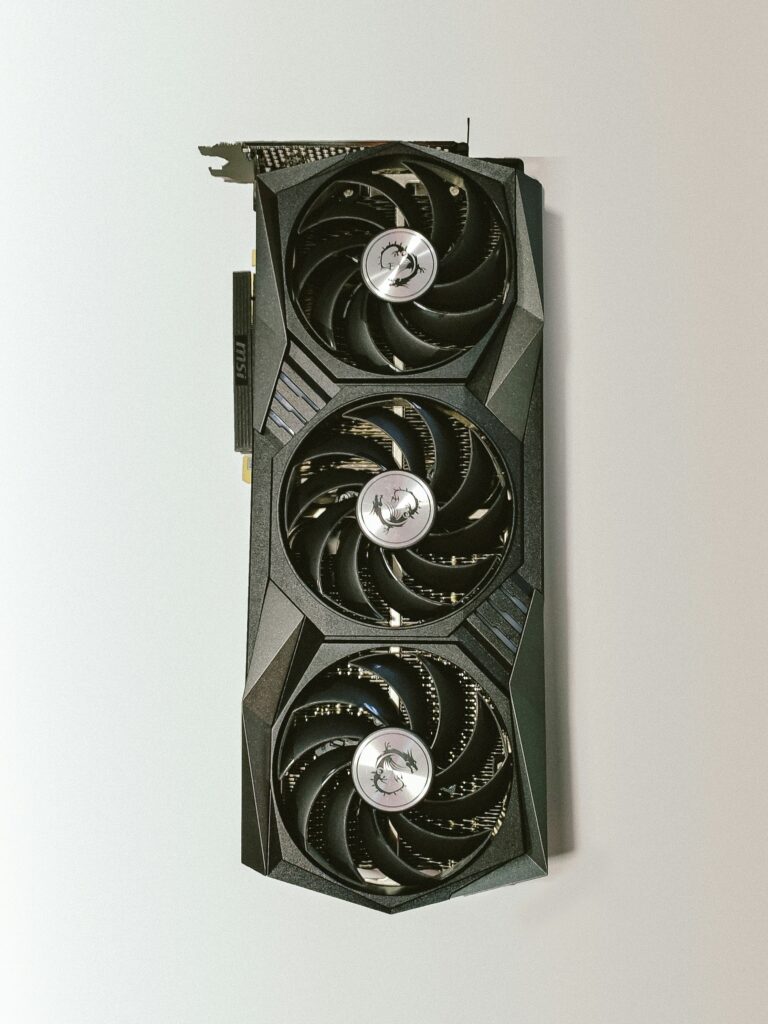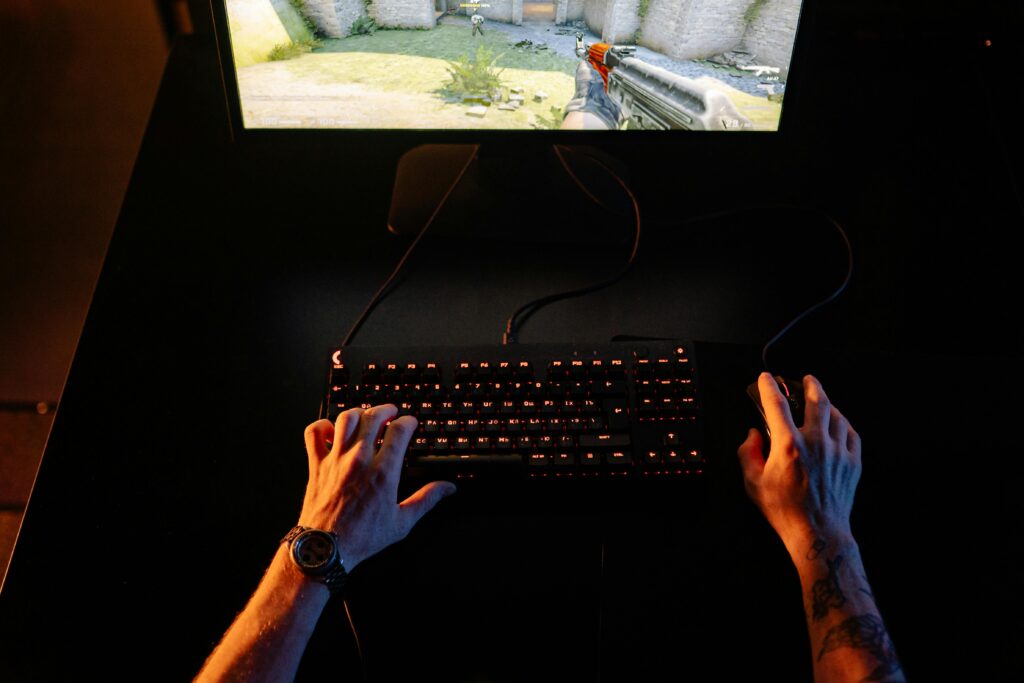Finding the Top GPUs for Gaming in 2025 can feel overwhelming – but we’ve broken it down for you.
Your graphics card is the most expensive and impactful part of your gaming rig. And in 2025, choosing the right one feels more like navigating a GPU jungle than making a simple upgrade.
Nvidia or AMD? 1440p or 4K? OC or reference? Ray tracing or max FPS?
We get it. It’s a mess.
But don’t worry – we’ve broken it all down without getting too technical, cutting through the noise to focus on what actually matters: winning games, not just running them.
Contents
- 1 Why Your Graphics Card Matters (More Than Ever)
- 2 Nvidia vs AMD: Which Side Are You On?
- 3 Card vs Card – 2025 Matchups
- 4 Skins, Coolers & Confusion – What Do Nvidia RTX Eagle, Ventus, Gaming X Trio Actually Mean?
- 5 GPU Generations Explained: From RTX 30 to 50-Series (Quick Overview)
- 6 RTX 50-Series (2025)
- 7 Which GPU Should You Get? By Game Type and Resolution
- 8 What Do GPU Specs Actually Mean?
Why Your Graphics Card Matters (More Than Ever)

Your skill can only take you so far.
In modern gaming, where frames win fights and milliseconds decide outcomes, your graphics card isn’t just part of your setup – it is your setup.
Whether you’re aiming for silky 240FPS in Valorant or chasing cinematic immersion in Cyberpunk, the GPU drives it all. It dictates your frame rate, your input responsiveness, and how clearly you see the enemy before they see you.
Low-end cards might “run” games – but in competitive lobbies or massive open worlds, they’ll choke, stutter, and cost you rounds. A good GPU turns your PC into a weapon. A top-tier one? Into a cheat code.
Nvidia vs AMD: Which Side Are You On?
When it comes to CPUs, AMD is the clear king — their Ryzen lineup has redefined performance per dollar. But when it comes to GPUs, the battlefield gets a lot messier.
For years, Nvidia has dominated the graphics card space, thanks to an unmatched blend of raw power and polished software. But don’t sleep on AMD. Their Radeon cards have been catching up fast, offering serious performance at aggressive price points.
The Software Edge: DLSS, Reflex, and Why Nvidia Still Leads
It’s not just about FPS anymore – it’s about the tools around it.
Nvidia’s ecosystem is stacked:
- DLSS 4 for AI-enhanced frame rates
- Nvidia Reflex to reduce input latency
- Broadcast for streamers and content creators
- ShadowPlay, NVENC, and seamless driver support
These features just work – and for many gamers, convenience is king.
AMD’s FSR (FidelityFX Super Resolution) is solid and getting better, but it’s still a step behind DLSS in image quality and game support. AMD’s drivers have improved dramatically, but Nvidia remains the plug-and-play choice for most setups.
Card vs Card – 2025 Matchups
To help you navigate the current GPU jungle, we’ve matched up Nvidia and AMD’s latest cards based on performance tier.
Whether you’re shopping top-of-the-line or mid-tier beast, here’s how the two brands stack up – side by side.
| Nvidia | AMD Equivalent |
|---|---|
| RTX 5090 | RX 8950 XT (Expected) |
| RTX 5080 | RX 7900 XTX |
| RTX 5070 | RX 9070 |
| RTX 5060 | RX 9060 XT |
| RTX 4070 Super | RX 7800 XT |
As you can see, the RTX 5090 is the undisputed heavyweight champion right now – no other card comes close in raw power.
But in the rest of the lineup, it’s a real fight. AMD and Nvidia both have strong contenders across performance tiers, and the ”best” card depends entirely on your needs, your budget, and your setup.
Whether you’re chasing ultra-high FPS, streaming, or just want a future-proof rig, this chart is just the beginning. Let’s dig deeper into what actually matters when picking the right GPU for your kind of gaming.
Skins, Coolers & Confusion – What Do Nvidia RTX Eagle, Ventus, Gaming X Trio Actually Mean?
Ever searched for a graphics card and found ten versions of the same model with names like Ventus, Eagle OC, TUF, or Gaming X Trio?
You’re not going crazy – and no, these aren’t just branding fluff.
These “skins” (a.k.a. partner cards) are different versions of the same GPU chip, built by third-party manufacturers like MSI, ASUS, Gigabyte, or Zotac.
What Actually Changes?
All Nvidia RTXs might share the same GPU core, but everything else can vary:
- Cooling: Triple-fan vs dual-fan, larger heatsinks, vapor chambers, etc.
- Factory Overclocking (OC): Some models come pre-tuned for higher boost clocks.
- Build quality: Better power delivery, quieter fans, and stronger backplates.
- Size: Some cards are huge — taking up 3 to 4 slots and stretching over 13 inches in length.
- Aesthetics: RGB, minimal stealth look, or aggressive gamer vibes – take your pick.
So… Which One Should You Get?
- Ventus / Dual-fan models – Great for tighter builds, lower price, decent performance.
- Gaming X Trio / ROG Strix / Aorus Elite – High-end cooling, higher factory OC, premium build.
- Eagle / TUF Gaming – Mid-tier balance between performance and price
- Founders Edition – Nvidia’s in-house card, clean design, solid cooling, and reference specs.
Quick Tip:
If you’re not planning to overclock manually and don’t care about max bling, go with a well-reviewed mid-tier model.
But if you want the absolute best thermal/noise performance or plan to push your card – those high-end triple-fan monsters are worth the extra bucks.
GPU Generations Explained: From RTX 30 to 50-Series (Quick Overview)
If you’ve been out of the loop for a few years, the GPU market has evolved – fast. From the raw power of the RTX 3080 to the mind-bending performance of the RTX 5090, every generation leap brings major shifts in speed, efficiency, and features.
Here’s a quick breakdown of how Nvidia’s recent generations compare, and what they mean for gamers in 2025.
RTX 30-Series (2020–2022)
- Released during the GPU shortage era
- Based on Ampere architecture
- Great 1440p and 4K performance
- Limited ray tracing performance
- No DLSS 3.0 support
- Still decent value if priced right — think used market
Key cards: RTX 3060 Ti, 3070, 3080, 3090
RTX 40-Series (2022–2024) – DLSS 3.0
- Built on Ada Lovelace architecture
- Major leap in ray tracing + AI upscaling (DLSS 3.0)
- Better power efficiency vs 30-series
- Some models had questionable pricing at launch
- Perfect for high refresh 1440p and 4K
Key cards: RTX 4070, 4070 Ti, 4080 Super, 4090
RTX 50-Series (2025)
- Based on Blackwell architecture (same as AI-focused GPUs)
- Even faster frame generation and better latency control
- Introduced DLSS 4.0
- Higher efficiency and cooler operation
- Ideal for 360Hz+ gaming, maxed 4K, and next-gen engines
Key cards: RTX 5060 (budget), 5070, 5080, 5090 (flagship)
So… Should You Skip a Generation?
If you’re still on a 20-series or older, yes – upgrade is worth it.
If you’re on 30-series, the jump to 50-series is real – especially if you play competitive or want future-proof performance.
40-series? You might hold off… unless you find a good deal or want bleeding-edge features.
What Kind of Performance Gains Can You Expect?
If you’re upgrading from an RTX 30-series card, you’re in for a noticeable jump – especially in newer titles optimized for ray tracing and DLSS.
Across popular games like Cyberpunk 2077, Modern Warfare III, and Starfield, here’s a rough breakdown of what to expect in raw performance uplift:
- RTX 30 → 40-series: Expect 30–50% more FPS at 1440p and 4K, especially when enabling DLSS 3.0 + Frame Generation. Ray tracing performance nearly doubles in supported titles.
- RTX 40 → 50-series: Gains are more subtle in raw FPS (15–25% uplift in most games), but latency, efficiency, and DLSS 4 push the experience to a new level – especially for esports and ultra high refresh rate play
- RTX 30 → 50-series: This is the biggest leap. In games like Cyberpunk with path tracing enabled, you’ll see 2x–3x the FPS when combining modern hardware with next-gen upscaling tech.
TL;DR: If you’re on a 30-series GPU and you’re gaming at 1440p or 4K – upgrading to a 50-series card is more than just future-proofing. It’s night and day.
Which GPU Should You Get? By Game Type and Resolution
You’ve seen the specs, compared the cards – but what should you actually buy?
Not everyone needs an RTX 5090 beast. Depending on what you play and how you play it, you might get better performance-per-dollar from a mid-tier option. Here’s how to match the right GPU to your gaming style – all based on the head-to-head matchups above.
Competitive Esports (1080p / Max FPS)

If your setup revolves around games like Valorant, CS2, League of Legends, or Fortnite, then what matters most isn’t ultra-high resolution — it’s raw, stable framerate and minimal latency.
The top GPUs for gaming in 2025 in this category aren’t necessarily the most expensive, but they are fast, efficient, and optimized for high refresh rate monitors. These cards deliver the frames you need to hit those headshots consistently.
Unlike cinematic singleplayer titles, competitive games rely on split-second precision. Your GPU needs to push 300+ FPS at 1080p without frame drops, input lag, or micro-stutter – even during smoke spam, ability chaos, or big teamfights.
That’s why GPUs like the RTX 4070 Super, RX 7800 XT, or even newer 50-series mid-range cards are ideal here. They don’t just crush esports titles – they do it while staying cool, quiet, and latency-free.
The top GPUs for gaming in 2025 at 1080p are built for efficiency, not ego. You don’t need a $2000 flagship to crush these games.
Top picks:
AAA Games @ 1440p (High Settings + Ray Tracing)

1440p is where most serious gamers are heading in 2025. It offers a noticeable jump in clarity over 1080p – without hitting the GPU wall that comes with 4K. It’s the new standard for high-end singleplayer experiences.
Titles like Starfield, Cyberpunk 2077, and Spider-Man 2 come to life at this resolution, especially with ray tracing turned on. But to enjoy that kind of visual fidelity without sacrificing framerate, you’ll need more than just a mid-tier GPU.
When choosing from the top GPUs for gaming in 2025 for this tier, you want a card with:
- 12GB+ of VRAM
- Strong ray tracing cores
- Access to DLSS 3.0/3.5 or FSR 2/3 for smart upscaling and frame gen
- Enough power to hit 60–120 FPS in modern AAA titles with high settings
This is where cards like the RTX 5080, RTX 4080 Super, and RX 7900 XTX shine. They’re built to handle heavy shaders, high resolutions, and demanding world streaming – without dropping frames or overheating.
The top GPUs for gaming in 2025 at 1440p give you cinematic quality without compromising playability.
Top picks:
4K Gaming (Ultra Settings)

4K isn’t just a resolution – it’s a lifestyle. If you’re the type who wants everything maxed, textures cranked, and zero compromise on detail, you’ll need one of the absolute top GPUs for gaming in 2025. And by top, we mean the top.
4K gaming isn’t just about pushing more pixels – it’s about holding high framerates while ray tracing, shaders, volumetrics, and physics all slam your system at once. That’s why 24GB+ of VRAM, top-tier cooling, and AI-powered upscaling aren’t optional – they’re required.
The RTX 5090 dominates this category, delivering 60–100+ FPS in fully maxed AAA titles – even with full path tracing enabled. Meanwhile, AMD’s upcoming RX 8950 XT could offer strong raster performance and more VRAM-per-dollar, though real-world benchmarks are still incoming.
Cards in this tier aren’t cheap. But if you’re running a 4K 144Hz or 240Hz monitor, they’re more than justified. You’re not just buying performance – you’re buying visual perfection without compromise.
Top picks:
Streaming, Content Creation, and Multi-Tasking

Gamers who also stream, edit, or create content need more than just raw framerate. You need stability, encoding horsepower, and bandwidth to handle heavy workloads without dropping frames or bogging down your system.
That’s where features like NVENC (Nvidia’s hardware encoder), AV1 support, and plenty of VRAM come into play. Nvidia still leads this space with its powerful driver stack, Studio drivers, and AI-powered tools – but AMD is closing the gap, especially in raw compute and multitasking performance.
Some of the top GPUs for gaming in 2025 also double as content creation beasts. Cards like the RTX 5080, RTX 5090 can game at max settings while encoding 4K streams, exporting videos, or running virtual camera tools in the background.
If you want to play, stream, record, edit, and render – all on one machine – you need a GPU that can juggle performance and productivity.
Top picks:
Budget-Conscious Performance (Still Want to Win)
Not everyone wants (or needs) a $1,500+ GPU. If you’re gaming at 1080p or dipping your toes into 1440p, there are excellent options that won’t burn your wallet.
The top GPUs for gaming in 2025 in this range still offer ray tracing, DLSS/FSR, and solid thermals. You won’t hit 4K ultra, but you’ll dominate in any esports title and get great performance in modern AAA games at medium settings.
Top picks:
What Do GPU Specs Actually Mean?
Modern graphics cards come loaded with specs – VRAM, boost clocks, core counts, and more. But which numbers actually matter? Here’s a quick breakdown so you don’t get lost in the marketing.
VRAM (Video RAM) – e.g., “32GB”
When you see a GPU listed with “32GB,” that refers to how much video memory it has. VRAM is crucial for handling textures, resolution, and modern visual effects – especially in 1440p and 4K gaming.
The more VRAM, the better your system can handle high-resolution games, mods, and future updates. 8–12GB is enough for most gamers today, but top-end cards like the RTX 5090 offer 24GB or even 32GB, giving you headroom for years to come.
GPU Clock Speed – “Base” and “Boost” MHz
Clock speed refers to how fast your GPU cores operate. Higher clock speeds generally mean faster performance — but it’s not everything.
Most modern cards have a base clock (normal operation) and a boost clock (when it’s under load and thermals allow). For example, a card might boost from 2.2 GHz to 2.8 GHz under pressure. Faster isn’t always better – efficiency and cooling matter too – but it’s a solid indicator of raw speed.
Don’t get spec-baited
Specs like VRAM and clock speed are helpful – but only when viewed in context. A well-optimized 16GB card can outperform a bloated 24GB one if the drivers, architecture, and cooling are better.
Always judge a GPU by real-world benchmarks, not just numbers on a box.
We hope this guide helped you cut through the GPU jungle and find the right graphics card for your setup.
Finding the Top GPUs for Gaming in 2025 doesn’t have to be overwhelming.
You don’t need a PhD in silicon architecture — just the right info.
Every card we’ve featured here brings serious power and purpose. Whether you’re going for max frames, cinematic visuals, or streaming — the right GPU can transform your entire experience.
Got a favorite card or brand we missed? Let us know at contact@nerdwells.com — we’re always updating our lineup.
Want to squeeze every drop of performance from your new GPU? Pair it with the right display — check out our Best Gaming Monitors for Competitive Gaming (2025 Edition)
→ Because frames mean nothing without the screen to show them.
Want to see what your new GPU is really capable of? Pair it with one of the year’s most immersive displays — check out our Best Immersive Gaming Monitors for 2025
→ Because raw power means nothing if the world you’re playing in doesn’t come alive.
